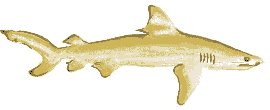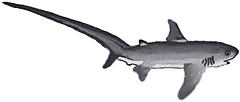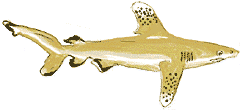|
Gulf of Mexico
- Bull Sharks (Carcharinus leucas) are grey with an off-white underside.
They have a blunt nose, stout body and no dorsal ridge. They are slow swimmers,
can breathe while at rest, and grow to about ten feet. They are the only
sharks who are just as happy in fresh water as salt water, and have been
found as far as 2,000 miles inland. Bull Sharks are world class travellers,
and have been sighted in Lake Nicaragua, Guatemala's Lake Yzabal, the
Spanish Main and New York, but their favorite hangouts are in shallow
waters along the continental shelves. They'll eat just about any kind of
fish, and even you if you give them a chance.

- The Thresher Shark (Alopia vulpinus), reaches a length of 13 to 20 feet, with a
tailfin nearly as long as the rest of its body. They love the warm
tropical and sub-tropical waters out in the open Atlantic and Pacific
Oceans, often feeding in groups on schools of small fish. They use their
long upper tail fin to stun small fish.

- The Nurse Shark (Ginglymostoma cirratum) has both dorsal fins set
far back. She has little eyes and a big nose with fleshy barbels hanging off
it which can actually detect prey hidden from view. That's lucky
for her because she can't see very well. If you leave her alone she'll
leave you alone, but if you pick a fight with her she will most certainly
attack you. A Nurse shark has conical teeth which it uses for crushing the
shells of crabs and mollusks. Nurse sharks replace a row of teeth
about every two weeks during warm weather. They are born with spots. But by the time they
reach 9 feet they turn grayish or yellowish-brown all over. They live on
the bottom of shallow waters in the Western Atlantic as far north as Rhode
Island and as far south as Brazil.

- The Hammerhead Sharks are born with their head bent backward so
they don't get stuck in the birth canal. They range in length from five
feet to over seventeen feet. The nostrils, as well as the eyes, are
located on the outer edges of the head. As the hammerhead swims, it
swings its head back and forth through the water, possibly increasing the
chances of detecting food. The head acts like a wing which makes the
shark more agile in the water and also creates a wide field of vision.
The Hammerhead can accelerate quickly when attacking because of a
streamlined body and powerful muscles.
- The Bonnethead (Sphyrna tiburo) is small and plentiful and often
seen in small groups of 10 to 20 individuals. They probably feel safer
that way since they are found in the stomachs of larger sharks.
- The Great Hammerhead Shark (Sphyrna mokarran) is taken for leather
and the Vitamin A content of its large oil filled liver. Females may
have a litter of 30 or more pups. It is found in warm waters worldwide.
- The Smooth Hammerhead Shark, (Sphyrna zygaena) doesn't have an
indentation at midline in the leading edge of the head which is evely
convex. They can be found both offshore and inshore, even entering
shallow bays like the Indian River. They eat fish and stingrays.
Sometimes stingrays can be a mistake though, because their spines get
imbedded in a shark's mouth. If you catch one of these Hammerheads on a line he'll put
up a good fight.

- The Oceanic White Tip Shark is an open-sea shark very rarely seen close
to land. Jacque-Yves Cousteau is a diver who goes out to meet
the sharks, though, and has reported that they are aggressive toward men.
Survivors of torpedoed ships in World War II have said the same thing.
It's latin name means "long hands" because of it has very long pectoral
fins. They are reported to school and feed on smaller fishes and sea
turtles.

- The Blacktip Shark (Carcharinus limbatus), is found in shallow water
and forms an important part of the commercial shark catch in Florida. It
is smooth backed, lacking a ridge, and of course, the tips of the dorsal,
pectoral, anal and lower caudal fin are all black. Size at maturity is
between 5.5 and 6.5 feet and maximum length may not exceed 8 feet. They
frequently swim in schools.

- The Sandbar Shark is also known as The Brown Shark. (Carcharinus
plumbeus) It's a medium sized shark with a large first dorsal fin that's
placed far forward, a much smaller second dorsal, and a ridged back. The
Sandbar Shark loves the warm waters in southern Florida but travels all
the way to the shallow bays of Long Island Sound to give birth to her
pups.
- The Shortfin Mako Shark has big pointy teeth, but Mama Mako never told
any of her children to chew their food. Once an unlucky tuna or mackerel
gets nabbed, the Mako Shark swallows it whole. It also likes to swim
along the ocean floor and catch the fish who keep a low profile. The
Shortfin Mako might be the winner in a shark beauty contest because it is
a beautiful blue on top and pure white underneath. An adult is usually
about 12 feet long.
- The Florida Smooth Hound Shark (Mustelus norrisi) schools off
southwest Florida. It likes shallow water in the winter when the water is cooler.
Its trunk is slender and the very noticeable dermal ridge extends along
the sides from above the first or second gill slit to the beginning of the
tail. It bears live baby sharks.
Harriet and Heming are swimming
in warm crystal clear waters.
Harriet says: "Testing, testing is your microphone working Heming?
We
have to head due north for our rendevous to New England,
or we'll have
to swim all the way." "Loud and clear Harriet.
What rendevous?"
|
- The Blacknose Shark (Carcharhinus acronotus) matures at 3.5 to 4.5
feet. A long snout with a
darkspot on it and asymmetrical upper teeth distinguish this shark. It's color can
be cream to yellowish-grey above, and a paler shade of the same or white
below. This kind of color differentiation is typical of almost all sharks
that frequent the upper layers of the oceans and is effecive camouflage
against the deeper water or bottom when viewed from a bove, and against the
light when seen from below.
- The Finetooth Shark is a small slender shark, an inshore species.
Its pointed, smooth-edged teeth suggest a fish eater. It is
recognizable by very long second dorsal fin
that is much smaller than the first dorsal. It is found on both sides of the
Atlantic.
- The Lemon Shark (Negaprion breverostris) is slim and elegant and
matures at about 7 feet. At a maximum lenth of 11 feet it will weigh only
about half as much as a tiger shark equally long. It is common in Gulf
waters including bays and salt creeks. It can look yellow which is why it
is called a Lemon Shark, but can also take on shades of gray or brown with
white or yellowish underparts. To identify, look for two almost equal
size dorsal fins, a blunt, rounded snout, and narrow, triangular
teeth, more pointed and erect in the lower jaw.


|







